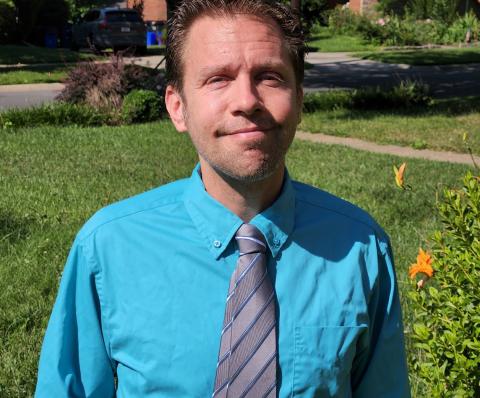A Closer Look at EyeGene
Employee Offers Personal Account of NIH-Supported Clinical Research

To truly understand someone’s experience, put yourself in their shoes. No doubt, you have heard this adage and it is certainly the case for the many people who participate in clinical research. Many of us who work at NIH regularly say how invaluable clinical study participants are to improving public health, but have you tried on their shoes yet?
I was first exposed to clinical research as a graduate student. Although financial compensation did provide some motivation (I was a poorly paid grad student after all), the promise of turning clinical research discoveries into public health benefit was the principal driver for my continued participation. As interesting and educational as these opportunities were, they did not study genetic retinal diseases that cause progressive vision loss—something close to home for me.
So, I searched “retinitis pigmentosa” in ClinicalTrials.gov, and inquired about a study. I soon received a response, which to my shock actually came from the then-director of the National Eye Institute. Those types of emails definitely stand out in your inbox.
The study was called the National Ophthalmic Disease Genotyping and Phenotyping Network (eyeGENE). The initiative aims to better understand the genes involved in rare genetic, inherited eye disease—in people with the disorders and in their families. It makes eye examination data and DNA samples, including whole genomes, as widely available as possible to qualified researchers. The goal is for these data to be used in future studies on eye diseases in hopes of accelerating pathways to treatments.
I have now participated in the program at the Clinical Center for more than a decade. Each visit can consist of many hours of tests beyond the traditional eye exam.
Clinicians start with the standard eye chart to assess visual acuity, then conduct a visual field exam to understand how much the eye sees in any direction without moving.
Occasionally, they need to know the electrical activity of the retina to see how that has changed over time. When I am hooked up to an electroretinalgram as part of the procedure, I feel like the main character in A Clockwork Orange who undergoes government aversion therapy.
The medical team may next use optical coherence tomography to map and measure distances between the retinal layers. Genetic testing will likely be offered too, which did confirm my earlier diagnosis. It also identified the specific gene mutation causing my progressive vision loss, helping explain the origins of my superhuman mutant power.
I learn something new about my vision loss each time. The staff are always helpful, kind and willing to answer every question I have. They review with me the results of the day, expected prognosis and any clinical trials that may be of interest.
Even at the very first visit, after realizing I am a scientist and did not want any sugar coating on my test results, my staff clinician sat back in his chair and said “ok, I’ll give it to you straight.” I have seen him multiple times since, and truly appreciate his honesty and candor.
More than 6,400 other people are part of the eyeGENE network from the U.S. and Canada, representing over 30 different eye diagnoses and experiences. Genomic information is available in the biobank for more than 95 percent of these participants. Their contributions have led to at least 90 publications and 32 secondary research studies.
I am pleased that my participation enriches the body of knowledge that researchers can use to move genetic eye research forward. It also had an unexpected side effect. Where once I was in obvious denial, the program helped me better embrace and learn to thrive with my own particular medical situation as I learned more about it.
I hope reading about this experience will encourage NIH staff to consider participating in a study, or at least pass along resources for others. Who knows, maybe you will find it an eye-opening experience too.
